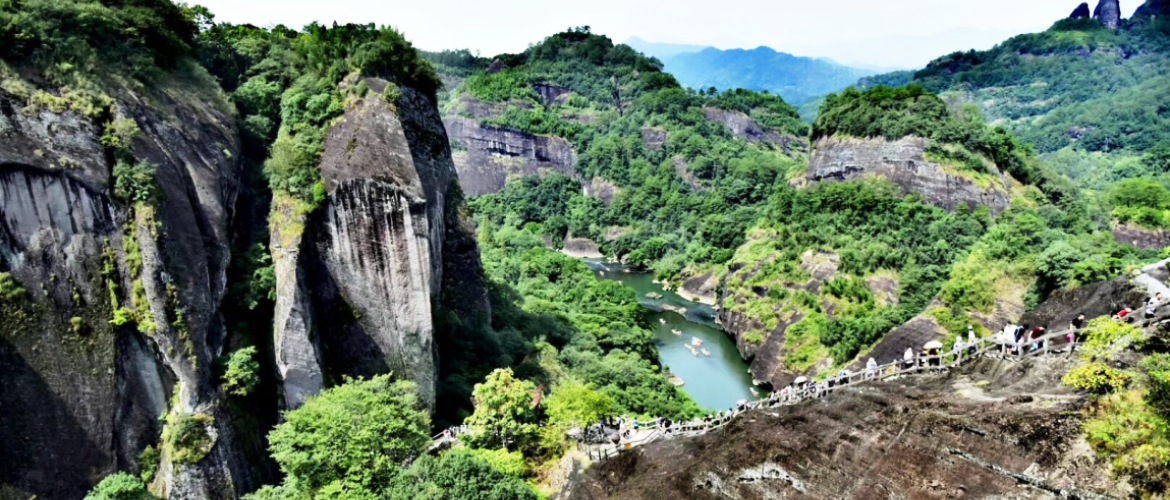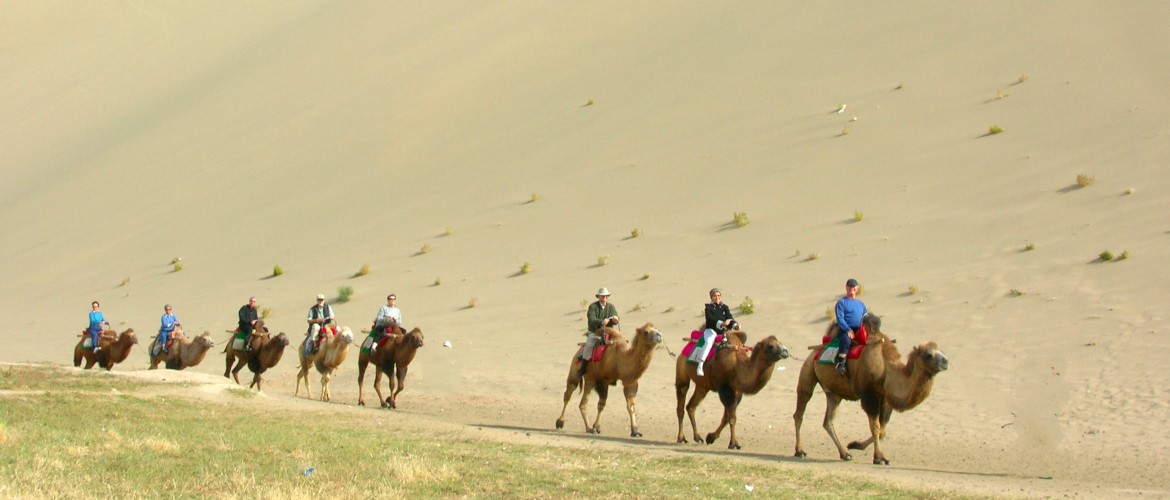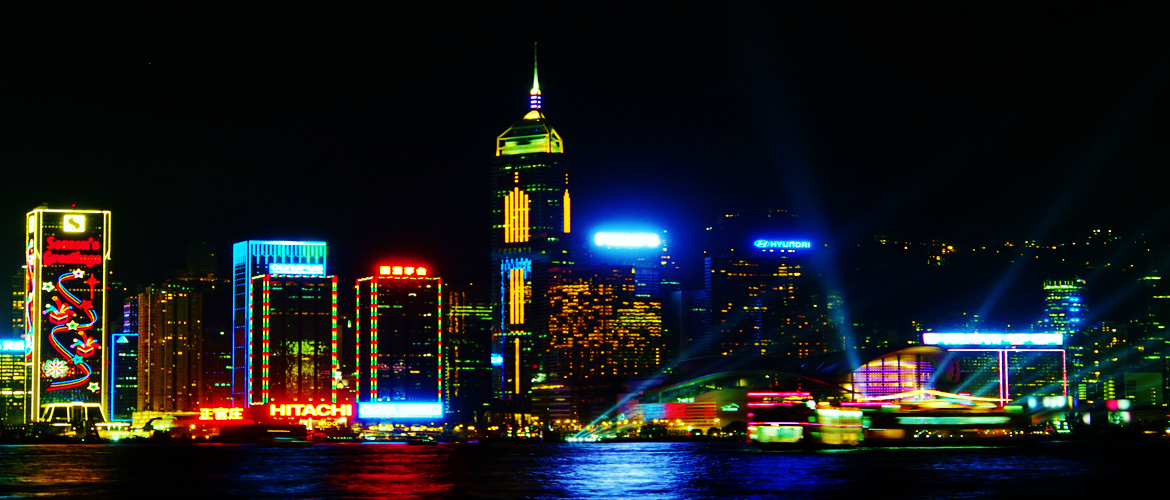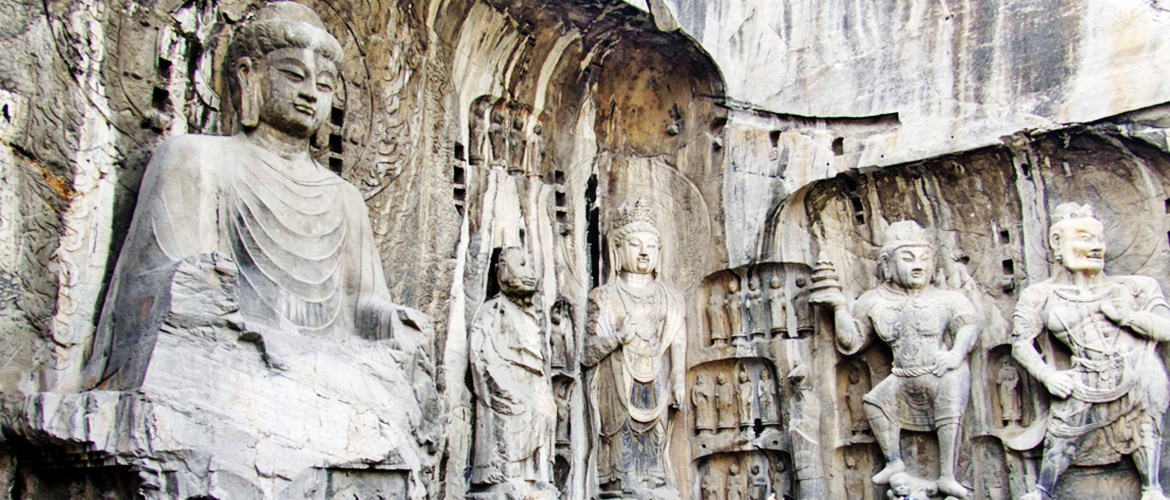| Land tour price without international airfare from: CA$18,750/US$13,390 Price is per person based on double occupancy. Please scroll down for departure dates and hotel list. |
Beijing – Luoyang – Lanzhou – Zhangye – Jiayuguan – Dunhuang – Kunming – Xianggelila – Lijiang – Chongqing – Hangzhou – Huangshan (Yellow Mountain) – Wuyishan (Wuyi Mountain) – Xiamen – Longyan – Guangzhou – Shenzhen – Hong Kong

This one-of-a-kind itinerary features Northwest China’s Gansu Province, retracing the footsteps of Marco Polo on the ancient Silk Road, visiting the Mogao Grottoes and the westernmost section of the Great Wall. The trip then delves into Southwest China’s Yunnan Province, an area blessed with stunningly beautiful landscapes, rich biodiversity, and intriguing ethnic cultural heritage. The last leg of the trip takes place along the Southeast Coast, boasting a collection of natural and historical UNESCO World Heritage Sites while offering visitors a deep insight into the modernization of China over the past four decades. The epic, well-rounded journey through China’s diverse landscapes provides a great balance between history, nature, and urban development.
This tour is designed for repeat visitors who have already explored China’s major cities, and are looking to discover lesser-known yet equally fascinating regions of the country.
Important Features
- Expert local guides hand-picked by company owners.
- Small group size – maximum 10.
- No annoying forced shopping stops of any kind.
- Quality meals at non-tourist restaurants.
- Unlimited supply of bottled water during group activities.
- Free Wi-Fi in all hotels.
- And so much more…
Meal Code: B = breakfast / L = lunch / D = dinner

Day 1/Mon: Departing for Beijing
Your China Grand Adventure tour starts with your transpacific flight departing from a city of your choice. You’ll lose a day upon crossing the International Date Line.
Day 2/Tue: Arrival in Beijing
Meet the driver on arrival for transfer to the hotel. You’ll have the remainder of the day at leisure.
Day 3/Wed: Beijing (B)
Free day to rest or explore on your own. An optional tour of Lama Temple is available upon request. Lama Temple was built in 1694 as residence of Prince Yong, one of the sons of Emperor Kangxi. After Prince Yong ascended the throne as Emperor Yongzheng in 1722, half of his former residence was turned into a lamasery – a monastery for monks of Tibetan Buddhism.
Beijing has so much to offer for repeat visitors other than the usual must-sees. Our recommendations include:
Beihai Park, a former imperial garden with a picturesque lake, white pagoda, and traditional pavilions, perfect for a relaxing stroll; Jingshan Park, right behind the Forbidden City, offers the best panoramic view of Beijing’s skyline; Beijing Capital Museum, a modern museum showcasing Beijing’s history and culture, with impressive exhibitions of ancient artifacts. 798 Art District, a trendy contemporary art zone filled with galleries, cafes, and street art.
Day 4/Thu: Beijing – Luoyang (B/D)
This morning we board the bullet train (G1591, 8:26/12:27) for Luoyang.
We spend the afternoon visitng the magnificent Longmen Grottoes, a UNESCO World Heritage Site. Located 12 km south of the city centre, the historical site contains as many as 100,000 Buddhist statues ranging from 1 inch to 57 feet in height. Dating back as far as 493 A.D., these ancient sculptures carved out of cliffs on both sides of the Yi River are some of the finest examples of Chinese Buddhist art.
Day 5/Fri: Luoyang (B/L)
Morning sightseeing includes White Horse Temple (the oldest Buddhist monastery in China) and the Peony Garden across from the monastery – the site of the annual peony festival held between early April and early May. We will then visit Luoyang Museum to explore artifacts dating from the Shang and Zhou dynasties (11th Century to 221 BC) , showcasing the rich history of the region. Also on our schedule is Luoyang Old Town. You can stroll along the ancient streets, admire the old architecture, and maybe shop for some local handicrafts.
Day 6/Sat: Luoyang – Lanzhou (B/D)
We board the high-speed train G2003 (09:24/14:07) to Lanzhou. A major link on the ancient Silk Road, Lanzhou is the capital of Gansu Province and a key regional transportation hub for northwest China with a population of 4.36 million (2020).
Upon arrival we visit Zhongshan Bridge, which was built in 1907 by Germans and is often referred to as the “First Bridge over the Yellow River”, and the historical White Pagoda (Baita) Hill Park across the bridge which offers a panoramic view of Lanzhou and the Yellow River. We will stop by the Yellow River Mother Sculpture, a symbol of the river’s nurturing role in Chinese civilization.
Day 7/Sun: Lanzhou – Zhangye (B/L/D)
After breakfast, we visit the Gansu Provincial Museum, which houses over 350,000 artefacts illustrating the history of Gansu as well as natural history. A major treasure of the museum is the Flying Horse of Gansu, a bronze sculpture from Han Dynasty, around the 2nd century AD. It has become a symbol of Chinese tourism. A replica is displayed in the United Nations Office in Geneva.
Take high speed train D2717(11:46/14:40) to Zhangye, a frontier city in the northwest of Gansu and one of the most important outposts on the Silk Road, historically known as Ganzhou (Campichu in Marco Polo’s journals). Nowadays Zhangye is renowned for its multi-colored rock formations known as Danxia Landforms. The naturally tinted foothills that blanket the area are so picturesque, one might wonder if they were hand-painted by artists.
Upon arrival, we drive to Zhangye National Geopark. The trails in the park are a series of leveled boardwalks allowing visitors to easily meander around the colorful sandstone landscapes.
Day 8/Mon: Zhangye (B/L)
This morning we go to the less-visited Binggou Landform Scenery Area located by the Liyuan Rivers to take in additional views of the colorful landscape.
Our sightseeing this afternoon includes Giant Buddha Temple, site of the largest reclining Buddha in China and the Wooden Pagoda nearby. The square surrounding the pagoda is popular amongst locals as a place to relax.
Day 9/Tue: Zhangye – Jiayuguan (B/L/D)
We check out after breakfast and drive to Jiayuguan, a small city named after the nearby Jiayu Pass, a key post of the ancient Silk Road.
Jiayu Pass is the largest and most intact pass at the western end of the ancient Great Wall. It is known in China as the “First and Greatest Pass Under Heaven”. The fortress was built in the Ming Dynasty in the 14th century. At that time, foreign merchants from Central Asia and West Asia mostly entered China through the gate here. The pass has a complex defense system that contains an inner city, a central area, and an outer city with a moat. Standing on the towers of the pass, you can find ancient military facilities such as arrow towers, turrets, and cannons along the wall, while taking in the view of the snow-capped Qilian Mountain in the distance.
Day 10/Wed: Jiayuguan – Dunhuang (B/L)
We drive to Dunhuang this morning. A major link on the ancient Silk Road, Dunhuang is an oasis city once known as Shazhou or “City of Sands”. The single biggest attraction in Dunhuang is the nearby Mogao Grottoes, which – along with Longmen Grottoes in Luoyang and Yungang Grottoes in Datong – form the three most famous Chinese grottoes of Buddhist sculptures, all on UNESCO’s list of World Cultural Heritage Sites.
Upon arrival, we take a short break and then visit Crescent Moon Lake and Singing Sand Dunes.
Day 11/Thur: Dunhuang (B/L)
Morning sightseeing introduces us to the brilliant murals and sculptures inside the Mogao Grottoes, one of the most celebrated legacies of the Silk Road era. Situated at a strategic point along the Silk Route, the 492 cells and cave sanctuaries in Mogao existed at the crossroads of trade and reflect religious, cultural and intellectual influences. Today, they are still famous for their statues and wall paintings, spanning 1,000 years of Buddhist art.
After lunch, we visit Dunhuang Museum. The rest of the afternoon is free.
Day 12/Fri: Dunhuang – Kunming (B)
We fly to Kunming today.
The capital of Yunnan Province, Kunming is known as the “city of eternal spring” due to its temperate climate. Sitting at 1,900 metres above sea level in the middle of the Yunnan-Guizhou Plateau, Kunming long profited from its position on the caravan roads through to Southeast Asia, India and Tibet. During the Second World War, Kunming became the terminus on the Chinese side of the famous Burma Road and also served as an airbase for the Allied Forces.
Day 13/Sat: Kunming – Stone Forest – Kunming (B/L/D)
Enjoy a full-day excursion to Stone Forest. Located 126 km southeast of Kunming, the UNESCO World Heritage Site is a massive collection of gray limestone pillars created by water erosion. The tall rocks protrude from the ground in a manner resembling stalagmites, with many looking like trees made of stone.
Day 14/Sun: Kunming – Xianggelila (B/L)
Our morning sightseeing includes the historic Western Hill Scenic Area and Huating Temple.
We board afternoon train C122 (13:14/18:22)to Xianggelila, primarily known as Shangri-La by westerners (3,160 metres/10,400 feet above sea level).
Day 15/Mon: Xianggelila (B/L/D)
In his 1933 novel Lost Horizon, British author James Hilton describes Shangri-La as a mystical, harmonious valley, gently guided from a lamasery, enclosed in the western end of the Kunlun Mountains. Some scholars believe that the Shangri-La story owes a literary debt to Shambhala, a mythical kingdom in Tibetan Buddhist tradition, which was sought by Eastern and Western explorers. Because of this remote association, the local authorities in Yunnan appealed to the State Council, the Chinese equivalent to the cabinet of a Western federal government, to have their county’s name changed from Zhongdian to Shangri-La (Xianggelila in Chinese pinyin) for the sake of promoting tourism. The application was approved in late 2001 and the name change soon went into effect.
We spend the morning exploring Pudacuo National Park. Stops include Bita Lake and Shudu Lake surrounded by virgin alpine forests. Designated as a national park on June 25, 2007, Pudacuo covers an area of 1,300 square kilometres. It is the first national park in China that meets the standards established by the International Union for Conservation of Nature. The park contains more than 20 percent of China’s plant species, about one-third of its mammal and bird species, and almost 100 endangered species. It is notably home to vulnerable black-necked cranes, many rare and beautiful orchids, and Himalayan yews – coniferous trees whose extracts are a source of the anticancer drug, paclitaxel.
Afternoon sightseeing takes in a Tibetan village, the Ganden Sumtseling Monastery, and a local market. Located 5 kilometres from the town of Zhongdian, the Ganden Sumtseling Monastery, also known as Sungtseling, is a Tibetan Buddhist monastery first built in 1679. Situated at 3,380 metres above sea level, it is the largest Tibetan Buddhist monastery in Yunnan province and is sometimes referred to as Little Potala Palace in reference to the Dalai Lama’s Potala Palace in Lhasa, Tibet.
Day 16/Tue: Xianggelila – Lijiang (B/L)
After breakfast we embark on an overland journey to Lijiang, The day-long drive covers 200 kilometres of country road snaking through scenic river valleys and high mountains dotted with villages of various ethnic nationalities. The highlight of the drive is a stop at the Tiger Leaping Gorge, the first bend of the Yangtze. The gorge is a 15 kilometre scenic canyon on the Jinsha River, a primary tributary of the upper Yangtze River. With a maximum depth of 3,790 metres, the Tiger Leaping Gorge is believed to be the deepest river canyon in the world.
Day 17/Wed: Lijiang (B/L)
Lijiang is home to the ethnic Naxi people whose Dongba religion and unique customs coupled with the region’s enchanting scenery make Lijiang and its vicinity a fascinating place to explore. Joseph Rock, the Austrian-American explorer, geographer, linguist, and botanist, spent almost three decades researching this part of China. The old town of Lijiang, known as Dayan, is protected as a UNESCO-designated World Cultural Heritage Site.
After a walking tour of the old town, we set out for an excursion to Yunshanping or Spruce Meadow, an alpine pasture surrounded by old-growth forests at the foot of Jade Dragon Snow Mountain. Afterwards, we visit an ancient village on our way back to the city.
Day 18/Thur: Xianggelila – Chongqing (B)
Free morning. We transfer to the airport and fly to Chongqing.
Day 19/Fri: Chongqing (B/L)
Enjoy a excusion to the renowned Dazu Rock Carvings, a UNESCO World Heritage Site, northwest of Chongqing (2-hour drive). Our sightseeing there includes Baodingshan Rock Carvings and Beishan Rock Carvings as well as Dazu Rock Carvings Museum.
Afternoon sightseeing takes in the People’s Square and Ciqikou, a historical waterfront district known for its porcelain production during the Ming and Qing dynasties.
Day 20/Sat: Chongqing – Hangzhou (B)
Free morning to relax. Take an early afternoon flight to Hangzhou, a city long celebrated for its natural beauty and cultural richness. Once praised by Marco Polo as “the finest and most splendid city in the world,” Hangzhou is best known for its idyllic West Lake, elegant gardens, ancient temples, and its legacy as a capital of art, tea, and silk. Today Hangzhou has transformed into China’s digital economy capital with Alibaba and many other giant corporations headquartered here. This well managed city is shaping China’s digital future while hornoring its poetic past.
Day 21/Sun: Hangzhou (B/L/D)
Spend a culturally enriching day exploring some of Hangzhou’s most iconic sites. Begin at Lingyin Temple, one of China’s most revered Buddhist temples, nestled in a serene forested valley. Marvel at the ancient rock carvings at Flying Peak, a limestone bluff adorned with hundreds of stone Buddhas. Continue to the Six Harmonies Pagoda, an architectural masterpiece offering sweeping views of the Qiantang River. Cap off the day with a relaxing boat cruise on West Lake, where you’ll glide past willow-lined banks, charming causeways, and postcard-perfect pavilions.
Day 22/Mon: Hangzhou – Huangshan/Yellow Mountain (B/L)
After a leisurely breakfast we take a short train ride to the city of Huangshan, namesake of the famous mountain literally meaning Yellow Mountain.
Known among Chinese as the loveliest mountain in their country, Yellow Mountain inspires visitors with its striking low-hanging clouds, distinctly shaped granite rocks and twisted pine trees. The jagged range consists of more than 70 knifelike peaks with the highest one reaching 1,864 metres above sea level. Vegetation on the range is thickest below 1,100 metres (3,600 ft), with trees growing up to the timberline at 1,800 meters (5,900 ft). Huangshan is a frequent subject of traditional Chinese paintings and literature, as well as modern photography.
Afternoon sightseeing takes place at Hongcun, a key component of the UNESCO World Heritage Site collectively known as Ancient Villages in Southern Anhui. The traditional village represents a type of non-urban settlement that largely disappeared or was transformed during the last century. The street plan, architecture and decoration, and the integration of houses with comprehensive water systems are unique surviving examples.
Day 23/Tue: Huangshan Scenic Area (B/L/D)
After breakfast, we drive to the mountain and reach one of the peaks by cable car, thus beginning our full day exploration of the mountain. Located in the southern part of Anhui Province, Huangshan is a marvel: within an area of 154 square kilometres there are as many as 72 peaks, whose names indicate the shapes they resemble. In 1990, UNESCO inscribed Huangshan a World Natural and Cultural Heritage Site. The beauty of Huangshan lies in its “four wonders”: pine trees with shapely foliage, peculiarly shaped rocks, the sea of clouds, and hot springs.
Day 24/Wed: Huangshan – Wuyishan (B/L/D)
This morning we board the bullet train for Wuyishan (1 hour 20 minutes).
UNESCO inscribed Wuyishan, or Wuyi Mountains, as a World Heritage Site in 1999 and describes the mountains as, “the most outstanding area for biodiversity conservation in south-east China and a refuge for a large number of ancient, relict species, many of them endemic to China.” The serene beauty of the dramatic gorges of the Nine Bend River, with its numerous temples and monasteries, many now in ruins, provided the setting for the development and spread of neo-Confucianism, which has been influential in the many cultures of East Asia since the 11th century. In the 1st century B.C., a large administrative capital was built at nearby Chengcun by the Han dynasty rulers. Its massive walls enclose an archaeological site of great significance.
We spend the day exploring the wonders of nature at Yixiantian, Huxiao Crag, and Tianyou Peak Scenic Area.
Day 25/Thu: Wuyishan (B/L)
Sightseeing at Wuyi Mountains continues. Visits to Xiamei Village and a local teahouse for refreshments are on the agenda. Activities scheduled for today include a 2-hour ride on a bamboo raft down a river snaking through spectacular scenery.
Day 26/Fri: Wuyishan – Xiamen (B/L/D)
After breakfast we ride the bullet train (D2325, 08:30/12:11) to Xiamen, a historical seaport city formerly known as Amoy in the West. Our afternoon sightseeing focuses on Gulangyu Island where major attractions include Shuzhuang Garden, Piano Museum, Haitian Tanggou and Longtou Road. A lot of Western style buildings were erected on Gulangyu when Xiamen was run by the British as a treaty port from 1842 and 1912. An expatriate community of Europeans and Japanese made up a large percentage of residents on Gulangyu before the communists took over China in 1949. Today, Gulangyu is a popular vehicle-free tourist destination with beautiful beaches and meandering streets lined with old colonial villas.
Day 27/Sat: Xiamen – Yongding Tulou – Xiamen (B/L)
After breakfast we embark on a day trip by high-speed train to Longyan (1 hour each way) to visit Chuxi Hakka Earth Buildings located in the town of Xiayang, Yongding County. The complex consists of 5 round and 31 square earth buildings, representing the best of Fujian Tulou (earth buildings), a UNESCO World Heritage Site. Our tour includes the showpiece, Jiqing Lou, and Hakka History Museum.
Day 28/Sun: Xiamen – Guangzhou (B/D)
Ride the high-speed train (4 hours) to Guangzhou this morning.
Guangzhou, formerly known outside China as Canton, is the capital of Guangdong, China’s most populous province with the largest economy. With a history of over 2,200 years, Guangzhou was long known as a major terminus of China’s Maritime Silk Road. The famous Canton Fair is the oldest and largest import and export fair in China. As a major finance hub, Guangzhou is a mega-city of immense wealth and unique Cantonese culture.
We spend the afternoon exploring Yue Xiu Park and the Guangzhou’s city museum right atop Yuexiu Hill. One of the oldest musuem in China, it offers a brief yet succinct overview of Cantonese history. Enjoy the city view atop of the ancient Ming-era five-story building.
Day 29/Mon: Guangzhou (B/L)
Our full-day sightseeing takes in Dr. Sun Yat-sen Memorial Hall,the Chen Family Temple, and Shamian Island where many European-style buildings exist due to its colonial history.
Day 30/Tue: Guangzhou – Shenzhen – Hong Kong (B/L)
The early morning train ride to Shenzhen takes only half an hour.
As a very young city, Shenzhen doesn’t offer much to the international visitor seeking a rich history, but driving around with a guide explaining the metamorphosis of Shenzhen from a small fishing village four decades ago to an incredibly prosperous mega-city today is a fascinating experience. Once you know the story of Shenzhen, you’ll find it much easier to wrap your head around the rapid rise of China. Shenzhen ranks as China’s third largest city with a metro population of 23.3 million (2010) and an economy rivalling that of Austria (2020 GDP US$433.3 billion).
Our first stop is Shenzhen Museum of Contemporary Art and Urban Planning, a striking modern complex that combines two museums in one. Located in the heart of Futian, the museum showcases innovative Chinese and international art alongside exhibits on Shenzhen’s rise from a fishing village to a tech metropolis. It offers an inspiring glimpse into China’s creative and urban future.
We then take a stroll through the nearby Lianhuashan Park, a lush green oasis beloved by locals offering panoramic views of the city from the Deng Xiaoping statue at the hilltop.
Late in the afternoon we cross the border into Hong Kong.
Day 31/Wed: Hong Kong (B/L)
Hong Kong (meaning “fragrant harbour”) is one of two special administrative regions of the People’s Republic of China, along with Macau. The transfer of sovereignty from the United Kingdom to China was completed in 1997. Comprising more than 260 islands, Hong Kong is one of the most densely populated territories in the world, with 7.4 million residents of various nationalities in a 1,104-square-kilometre (426 sq mi) territory.
Our morning guided sightseeing begins with a ferry ride across Victoria Harbour from Tsim Sha Tsui to Central, the heart of Hong Kong’s business district and home to the regional headquarters of many multinational financial services corporations. Consulates general and consulates of many countries are located in this area, as is the government of Hong Kong.
We then proceed to Victoria Peak located in the western half of Hong Kong Island. Also known as Mount Austin or The Peak among locals, Victoria Peak, with an altitude of 552 meters (1,811 feet), offers sweeping views over Central, Victoria Harbour, and the surrounding islands.
After stopping by Repulse Bay, we dine in a nice restaurant for our farewell luncheon. Repulse Bay is a long stretch of beautiful sand beaches, over which the stately residences of Hong Kong’s rich and famous overlook. If time permits, we’ll also take a sampan ride in Aberdeen, the floating community showcasing Hong Kong’s fishing village roots.
The afternoon is set aside for you to explore on your own.
Day 32/Thu: Returning Home (B)
Transfer to the airport on your own for return home flight. Taxi to the airport costs about US$30 and is highly recommended for couples and families.

| City | Nights | Hotel | Category |
| Beijing | 2 | New Otani Chang Fu Gong | luxury |
| Luoyang | 2 | Courtyard by Marriott | luxury |
| Lanzhou | 1 | Hyatt Regency Lanzhou | luxury |
| Zhangye | 2 | Zhangye Hotel | 1st class (best available) |
| Jiayuguan | 1 | Nuojin Hotel | 1st class (best available) |
| Duhuang | 2 | Silk Road Hotel | 1st class (best available) |
| Kunming | 2 | Sofitel Kunming | luxury |
| Xianggelila | 2 | Shangri-La Resort | luxury |
| Lijiang | 2 | Jinmao Hotel Lijiang | luxury |
| Chongqing | 2 | Glenview ITC Plaza | luxury |
| Hangzhou | 2 | Midtown Shangri-la Hangzhou | luxury |
| Huangshan | 2 | Crowne Plaza | luxury |
| Wuyishan | 2 | C & D Resort Wuyishan | luxury |
| Xiamen | 2 | Pan Pacific | luxury |
| Guangzhou | 2 | Crowne Plaza | luxury |
| Hong Kong | 2 | Harbour Grand Kowloon | luxury |
|
Dates & Prices
discount available
| Depart (Mon) |
Return (Thur) |
Land Only* CA$/US$ |
Single Supplement CA$/US$ |
| 2025 | |||
| 06-Oct | 06-Nov | $18,750/$13,390 | $4390/$3090 |
| 2026 | |||
| 04-May | 04-Jun | $19,590/$13,990 | $4390/$3090 |
| 31-Aug | 01-Oct | $19,590/$13,990 | $4390/$3090 |
| 05-Oct | 05-Nov | $19,590/$13,990 | $4390/$3090 |
* Land Only price excludes international airfare. Please contact us for a fare quote.
|
What the tour price includes:
|
What the tour price excludes:
See Terms & Conditions for more information. |

